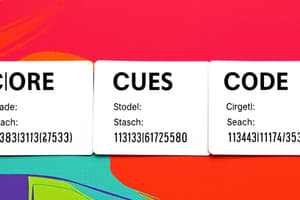Podcast
Questions and Answers
What was the primary economic interest of American farmers in relation to the Mississippi River and New Orleans in the early 19th century?
What was the primary economic interest of American farmers in relation to the Mississippi River and New Orleans in the early 19th century?
- Controlling the fur trade with Native American tribes.
- Accessing fertile land for cotton cultivation.
- Securing a route to transport crops to market efficiently. (correct)
- Establishing trade relationships with European powers.
How did Toussaint L’Ouverture’s actions in the French Caribbean influence Napoleon's decision to sell the Louisiana Territory to the United States?
How did Toussaint L’Ouverture’s actions in the French Caribbean influence Napoleon's decision to sell the Louisiana Territory to the United States?
- By convincing Napoleon to focus on expanding French territories in Europe instead.
- By negotiating a secret treaty with the United States to undermine French interests in North America.
- By leading a successful slave revolt that prevented France from utilizing Louisiana as a supply base for sugar plantations. (correct)
- By proving that France could not maintain control over its colonies in the Americas.
Why did the prospect of Napoleon's control over Louisiana concern frontier farmers in the United States?
Why did the prospect of Napoleon's control over Louisiana concern frontier farmers in the United States?
- They believed that Napoleon would incite Native American tribes to attack American settlements.
- They feared the expansion of French culture and influence into American territories.
- They worried that Napoleon would reimpose mercantilist policies, restricting their trade opportunities.
- They were concerned that Napoleon would close the port of New Orleans, preventing them from exporting their goods. (correct)
What constitutional concerns were raised by opponents of the Louisiana Purchase?
What constitutional concerns were raised by opponents of the Louisiana Purchase?
In what way did the Louisiana Purchase align with President Jefferson's broader vision for the United States?
In what way did the Louisiana Purchase align with President Jefferson's broader vision for the United States?
How did the Louisiana Purchase affect the dynamic between the eastern and western regions of the United States in the early 19th century?
How did the Louisiana Purchase affect the dynamic between the eastern and western regions of the United States in the early 19th century?
What role did James Monroe play in the Louisiana Purchase negotiations?
What role did James Monroe play in the Louisiana Purchase negotiations?
What factors motivated Napoleon Bonaparte to offer the entire Louisiana Territory for sale, rather than just New Orleans?
What factors motivated Napoleon Bonaparte to offer the entire Louisiana Territory for sale, rather than just New Orleans?
How did the Louisiana Purchase contribute to the concept of 'Manifest Destiny' in the 19th-century United States?
How did the Louisiana Purchase contribute to the concept of 'Manifest Destiny' in the 19th-century United States?
What was the initial offer for the purchase of New Orleans made by the United States?
What was the initial offer for the purchase of New Orleans made by the United States?
How did the Louisiana Purchase impact the United States' relationship with Native American tribes?
How did the Louisiana Purchase impact the United States' relationship with Native American tribes?
What was the primary concern of politicians in the Eastern states regarding the Louisiana Purchase?
What was the primary concern of politicians in the Eastern states regarding the Louisiana Purchase?
What was the reaction of frontier farmers to the news of the Louisiana Purchase?
What was the reaction of frontier farmers to the news of the Louisiana Purchase?
How did the Louisiana Purchase influence the development of the American legal system?
How did the Louisiana Purchase influence the development of the American legal system?
What was the final price agreed upon for the Louisiana Purchase, as paid by the United States to France?
What was the final price agreed upon for the Louisiana Purchase, as paid by the United States to France?
Which country did Louisiana belong to before France reacquired it in 1800?
Which country did Louisiana belong to before France reacquired it in 1800?
What were Napoleon's initial plans for Louisiana after reacquiring it?
What were Napoleon's initial plans for Louisiana after reacquiring it?
How did the Louisiana Purchase affect the economic relationship between the United States and Europe?
How did the Louisiana Purchase affect the economic relationship between the United States and Europe?
What was the significance of New Orleans to the United States prior to the Louisiana Purchase?
What was the significance of New Orleans to the United States prior to the Louisiana Purchase?
What was President Jefferson's justification for proceeding with the Louisiana Purchase despite concerns about its constitutionality?
What was President Jefferson's justification for proceeding with the Louisiana Purchase despite concerns about its constitutionality?
Flashcards
What was the Louisiana Purchase?
What was the Louisiana Purchase?
The Louisiana Purchase involved America's first opportunity for expansion to the west of the Mississippi River.
Who acquired Louisiana from Spain in 1800?
Who acquired Louisiana from Spain in 1800?
In 1800, the French ruler Napoleon Bonaparte convinced Spain to return Louisiana to France.
Who did Jefferson send to France?
Who did Jefferson send to France?
President Thomas Jefferson sent James Monroe to France to offer to buy New Orleans for $7.5 million in 1803.
What was Monroe's surprise proposal?
What was Monroe's surprise proposal?
Signup and view all the flashcards
Study Notes
Dynamic Programming - Edit Distance
- Dynamic programming is used to determine the minimum number of edits needed to transform one string into another.
- Edit operations include inserting, deleting, or replacing a character.
Substructure
- E(i, j) represents the edit distance between x[1...i] and y[1...j].
- If x[i] = y[j], then E(i, j) = E(i-1, j-1), indicating no edit is needed.
- If x[i] ≠ y[j], the edit distance is the minimum of the following: inserting y[j], deleting x[i], or replacing x[i] with y[j], each with a cost of 1.
Recurrence Relation
- For base cases, E(i, 0) = i and E(0, j) = j for all i and j.
- The general case involves checking if characters match and choosing the minimum edit distance accordingly.
- If $x[i] = y[j]$, $E(i, j) = E(i-1, j-1)$.
- If $x[i] \neq y[j]$, $E(i, j) = \min{E(i, j-1) + 1, E(i-1, j) + 1, E(i-1, j-1) + 1}$.
Dynamic Programming Approach
- The edit distance table is computed in a bottom-up manner.
- The algorithm iterates through the matrix, filling in values based on the recurrence relation.
- Running time is $O(mn)$, with space complexity of $O(mn)$.
Example: food → money
- The edit distance table shows the minimum edits needed at each step.
- The calculated edit distance between "food" and "money" is 4.
Physics: Rotational Motion
Torque
- Torque ($\tau$) is the turning effect of a force and is a vector quantity.
- $\tau = rF\sin\theta$, where $r$ is the distance from the axis of rotation, $F$ is the force magnitude, and $\theta$ is the angle between the force and lever arm.
- Can alternatively be represented as $\tau = r_{\perp}F = rF_{\perp}$.
- The direction of the torque is given by the right-hand rule, perpendicular to the plane formed by $r$ and $F$.
- The net torque ($\tau_{net}$) is the sum of all torques: $\tau_{net} = \sum \tau = \tau_1 + \tau_2 +...$
Torque and Angular Acceleration
- Angular acceleration is directly proportional to the net torque: $\tau = I\alpha$.
- $I$ is the moment of inertia, and $\alpha$ is the angular acceleration.
- Moment of Inertia ($I$) measures an object's resistance to changes in rotational motion and is $I = \sum mr^2$.
- The parallel-axis theorem: $I = I_{CM} + Md^2$, where $I_{CM}$ is the moment of inertia about the center of mass, $M$ is the total mass, and $d$ is the distance between the two axes.
Rotational Kinetic Energy
- Rotational kinetic energy $K_R = \frac{1}{2}I\omega^2$, where $I$ is the moment of inertia, and $\omega$ is the angular speed.
- Total kinetic energy of a rolling object: $K = \frac{1}{2}Mv^2 + \frac{1}{2}I\omega^2$, where $M$ is the mass and $v$ is the linear speed.
Work and Power in Rotational Motion
- Work done by torque: $W = \int_{\theta_i}^{\theta_f} \tau d\theta$, or $W = \tau\Delta\theta$ if torque is constant.
- Power delivered by torque: $P = \tau\omega$.
Angular Momentum
- Angular momentum of a particle: $L = r \times p = r p \sin\theta$.
- Angular momentum of a rigid object: $L = I\omega$.
- Conservation of angular momentum: $\sum L_i = \sum L_f$ if the net external torque is zero.
- Angular impulse: $\Delta L = \int \tau dt$, or $\Delta L = \tau \Delta t$ if torque is constant.
Rolling Motion
- For rolling without slipping: $v = R\omega$, where $v$ is linear speed, $R$ is the radius, and $\omega$ is angular speed.
- Total kinetic energy: $K = \frac{1}{2}Mv^2 + \frac{1}{2}I\omega^2$.
- When rolling down an incline, acceleration is less than $g\sin\theta$ due to rotational inertia.
Studying That Suits You
Use AI to generate personalized quizzes and flashcards to suit your learning preferences.




